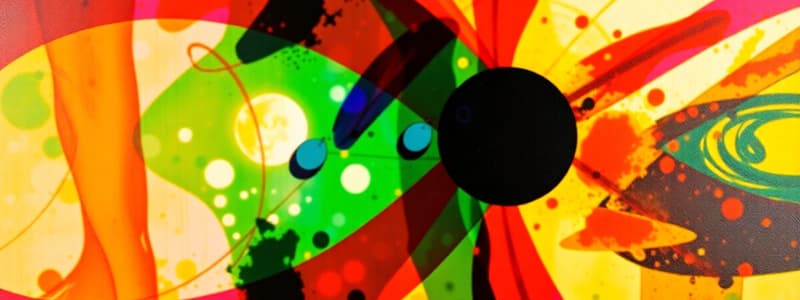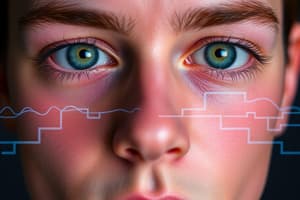Podcast
Questions and Answers
What is referred to as the minimum stimulation needed to detect a particular stimulus 50% of the time?
What is referred to as the minimum stimulation needed to detect a particular stimulus 50% of the time?
- Absolute Threshold (correct)
- Just Noticeable Difference
- Perception
- Transduction
Which of the following best defines transduction in the context of sensation?
Which of the following best defines transduction in the context of sensation?
- The study of relationships between stimuli and sensations.
- The ability to notice differences in stimulus intensity.
- The process of sensory input assembling into a meaningful pattern.
- The conversion of physical energy into neural signals. (correct)
According to Weber's Law, how is the Just Noticeable Difference (JND) related to the original stimulus intensity?
According to Weber's Law, how is the Just Noticeable Difference (JND) related to the original stimulus intensity?
- It is dependent on the individual’s sensory perception.
- It is a constant fixed amount regardless of stimulus intensity.
- It is a constant proportion of the original stimulus intensity. (correct)
- It varies inversely with stimulus intensity.
What is the primary role of sense organs in the process of sensation?
What is the primary role of sense organs in the process of sensation?
Which one of these senses is primarily associated with the sensation of pressure?
Which one of these senses is primarily associated with the sensation of pressure?
What does perception involve as per the given content?
What does perception involve as per the given content?
What does psychophysics study?
What does psychophysics study?
If a person can detect a weight difference of 5 grams when lifting 100 grams, what would Weber's Law predict for a 200 gram weight?
If a person can detect a weight difference of 5 grams when lifting 100 grams, what would Weber's Law predict for a 200 gram weight?
Which statement about personal interpretations of the real world is true?
Which statement about personal interpretations of the real world is true?
Which of the following represents a type of sensory receptor for smell?
Which of the following represents a type of sensory receptor for smell?
What does Signal Detection Theory predict?
What does Signal Detection Theory predict?
What does the vestibular system primarily help with?
What does the vestibular system primarily help with?
Which type of perception relies on prior knowledge and experiences?
Which type of perception relies on prior knowledge and experiences?
What phenomenon describes the inability to perceive stimuli that are actually sensed?
What phenomenon describes the inability to perceive stimuli that are actually sensed?
How are sound waves characterized?
How are sound waves characterized?
Which of the following is a monocular depth cue?
Which of the following is a monocular depth cue?
What happens during motion sickness according to Sensory Conflict Theory?
What happens during motion sickness according to Sensory Conflict Theory?
Which describes the phenomenon where distant objects are perceived differently in size compared to closer ones?
Which describes the phenomenon where distant objects are perceived differently in size compared to closer ones?
Which of the following components does not belong to the somesthetic senses?
Which of the following components does not belong to the somesthetic senses?
Which of the following characteristics does NOT define bottom-up processing?
Which of the following characteristics does NOT define bottom-up processing?
Flashcards
Sensation
Sensation
The process of detecting, converting, and transmitting sensory information from the sense receptors to the brain.
Perception
Perception
The experience of assembling and combining raw sensory input into meaningful patterns and images in the brain.
Psychophysics
Psychophysics
The study of the relationship between physical stimuli and the sensations they evoke in a human observer.
Absolute Threshold
Absolute Threshold
Signup and view all the flashcards
Just Noticeable Difference (JND)
Just Noticeable Difference (JND)
Signup and view all the flashcards
Weber's Law
Weber's Law
Signup and view all the flashcards
Transduction
Transduction
Signup and view all the flashcards
Sensory Receptors
Sensory Receptors
Signup and view all the flashcards
Sense Organs
Sense Organs
Signup and view all the flashcards
Perceptions
Perceptions
Signup and view all the flashcards
Signal Detection Theory
Signal Detection Theory
Signup and view all the flashcards
Kinesthesis
Kinesthesis
Signup and view all the flashcards
Vestibular Sense
Vestibular Sense
Signup and view all the flashcards
Motion Sickness
Motion Sickness
Signup and view all the flashcards
Selective Attention
Selective Attention
Signup and view all the flashcards
Divided Attention
Divided Attention
Signup and view all the flashcards
Inattentional Blindness
Inattentional Blindness
Signup and view all the flashcards
Perceptual Set (Perceptual Expectations)
Perceptual Set (Perceptual Expectations)
Signup and view all the flashcards
Bottom-Up Processing
Bottom-Up Processing
Signup and view all the flashcards
Study Notes
Sensation and Perception
- Knowledge originates from perceptions.
- Sensation involves detecting, converting, and transmitting sensory information from receptors to the brain.
- Perception involves assembling sensory input into meaningful patterns in the brain. Perceptions are personal interpretations of the world.
- Psychophysics studies the relationship between physical stimuli and sensations.
- Transduction converts physical energy (sound, light, pressure) into neural signals.
Sensation Thresholds
- Absolute threshold is the minimum stimulation needed to detect a stimulus 50% of the time.
- Just Noticeable Difference (JND) is the minimum difference between two stimuli detectable 50% of the time.
- Weber's Law: JND is a constant proportion of the original stimulus, not a constant amount.
- Signal Detection Theory predicts how/when we detect a signal against background noise. Thresholds vary between people and are not absolute.
Somesthetic Senses
- Somesthetic senses include vestibular (balance), kinesthetic (body position/movement), and touch (pressure, warmth, cold, pain).
- Kinesthesis senses position and movement; Vestibular senses balance and position relative to gravity. Semicircular canals filled with fluid sense head motion.
Body Position and Movement
- Vestibular system relates to balance. Motion sickness results from sensory conflict (between vestibular, visual, and body sensations).
Vision and Hearing
- Audition (hearing) transduces air pressure waves into neural impulses. Sound waves have amplitude (loudness) and frequency (pitch).
- Sound localization occurs because sounds reach the nearest ear first and are louder in that ear.
Factors Influencing Perception
- Attention (selective, divided, cocktail party effect)
- Inattentional blindness (e.g., change blindness) limits what is perceived.
- Expectations and motivation bias our perception.
Depth Perception
- Depth perception allows us to judge distance and see the world in three dimensions. The visual cliff study illustrates depth perception in infants.
Monocular Depth Cues
- Monocular cues use one eye to perceive distance, including linear perspective, relative size, relative height, light/shadow, interposition, and texture gradients
Binocular Depth Cues
- Binocular cues use both eyes to perceive distance, such as convergence and retinal disparity.
Perceptual Constancies
- Perceptual constancies allow us to perceive objects as stable despite changing retinal images (color, size, shape).
Perceptual Expectations/Set
- Past experiences/expectations shape perceptual interpretation.
Top-Down vs. Bottom-Up Processing
- Top-down processing is conceptually driven. It starts with expectations and prior knowledge.
- Bottom-up processing is data-driven. It starts with raw sensory input.
Additional notes
- Parallel Processing: Stimuli are processed simultaneously.
- Perceptual Adaptation: Adjustments to changed sensory input.
Studying That Suits You
Use AI to generate personalized quizzes and flashcards to suit your learning preferences.




